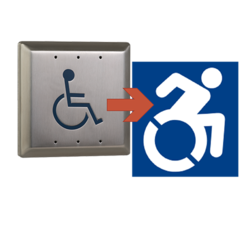|
|
Friday, June 15, 2018
The Controversy Surrounding The New Accessibility Icon/Symbol

It might seem strange that an icon would cause so much controversy. The new accessibility symbol might seem harmless enough to many but to some the "Accessible Icon," as it's known as, is creating quite a stir and a bit of confusion. In fact, using the new symbol has important legal implications.
Known variously as the Wheelchair Symbol or "the little blue sign," the currently legislated International Symbol of Access (ISA) features an individual sitting "motionless" on their wheelchair and is easily recognized around the world.
The (new) Accessible Icon, which began as a Boston-based street art project features a person in an active stance propelling themselves forward on a wheelchair, a symbolic action that emphasizes the person and differing abilities over a chair and disability.
While there was no initial intention of creating a new ISA symbol, this piece of art has received a lot of attention, bringing about conversation for a desire for change and has ultimately grown into an international crusade.
The Forward Movement, an Ontario based initiative that promotes physical and social inclusion for people of all abilities, want the "Dynamic Symbol of Access," as they call it, to be introduced and adopted across the province. Currently only six cities including Toronto, have adopted the dynamic symbol.
Despite its supposed success, the new wheelchair symbol has prompted a variety of reactions.
Those anxious for change see the old symbol as dated in both design and representation. Some believe that the old symbol places more emphasis on the wheelchair and disability instead of the person, while the new symbol shows movement, a symbolic action that highlights differing abilities.
Conversely, the new symbol is also being criticized by many within the disability community. They see the new design as a useless initiative. They don't want a new symbol, but rather meaningful reductions in their impediments to mobility, equality and economic opportunity.
What many jurisdictions do seem to agree upon, is that changing the symbol can only do so much. What really matters is how people with disabilities are viewed and treated within society.
While many jurisdictions are adopting the new symbol for signage, it is important to know that the symbol approved for use on code compliant switches is mandated under state/provincial, federal and international law. Specifically, the symbol used on push plate switches is defined by ANSI standards (A117.1) and is also mandated under a UN resolution. To be legally used on push plate switches, the ANSI standard (and ideally the UN resolution) would have to change to allow it, or the local authority having jurisdiction must choose to not enforce this requirement.
Since the use of the new symbol is actually prevented from being used on push plate switches by law, businesses that do not use the traditional ISA symbol required by code could be exposed to liability.
Camden has been aware of the 'alternative' wheelchair symbol for some time now. As a response we have switches that feature the new accessible symbol debossed with a paint filled graphic.
So, while we do have the new symbol available for your order, we must stress that while many places are adopting the symbol for signage, it has NOT been accepted for use on push plate switches. We advise that before using the new accessibility symbol in place of ISA, you first seek guidance from your local authority having jurisdiction.
In the midst of all the controversy, we will keep you up to date as soon as we have more information. Let us know if you have any questions.
|


